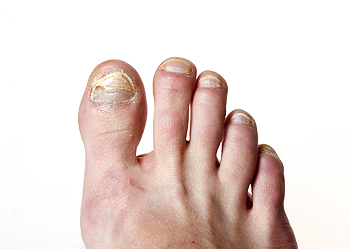
Toenail fungus, or onychomycosis, affects up to 14 percent of the population, with a higher incidence in toenails. Symptoms include discoloration, thickening, brittleness, and nail distortion. Advanced cases of toenail fungus may involve nail detachment, causing pain and potential infections. Fungal nail infections result from exposure to environmental fungi, exploiting small cracks in nails or surrounding skin. Risk factors include nail injuries, foot deformities, and trauma, creating entry points for fungi. Diabetes increases susceptibility due to compromised circulation and weakened immunity. Cancer or conditions suppressing the immune system elevate vulnerability. Poor leg circulation, such as venous insufficiency, or narrowed arteries, signaling peripheral artery disease, can contribute to the susceptibility for fungal nail infections. Those with a history of fungal skin infections are also more prone, especially anyone with a weakened immune system. Secondary bacterial infections are common in people with diabetes, amplifying health risks. Understanding toenail fungus causes and symptoms is essential for early detection. If you believe you have developed a toenail fungus infection, it is suggested that you schedule an appointment with a podiatrist who has advanced measures that can help rid you of this stubborn condition.
If left untreated, toenail fungus may spread to other toenails, skin, or even fingernails. If you suspect you have toenail fungus it is important to seek treatment right away. For more information about treatment, contact Edward Sharrer, DPM of Crestwood Podiatry and Wound Care Clinic. Our podiatrist can provide the care you need to keep you pain-free and on your feet.
Symptoms
- Warped or oddly shaped nails
- Yellowish nails
- Loose/separated nail
- Buildup of bits and pieces of nail fragments under the nail
- Brittle, broken, thickened nail
Treatment
If self-care strategies and over-the-counter medications does not help your fungus, your podiatrist may give you a prescription drug instead. Even if you find relief from your toenail fungus symptoms, you may experience a repeat infection in the future.
Prevention
In order to prevent getting toenail fungus in the future, you should always make sure to wash your feet with soap and water. After washing, it is important to dry your feet thoroughly especially in between the toes. When trimming your toenails, be sure to trim straight across instead of in a rounded shape. It is crucial not to cover up discolored nails with nail polish because that will prevent your nail from being able to “breathe”.
In some cases, surgical procedure may be needed to remove the toenail fungus. Consult with your podiatrist about the best treatment options for your case of toenail fungus.
If you have any questions, please feel free to contact our office located in North Little Rock, AZ . We offer the newest diagnostic and treatment technologies for all your foot care needs.



